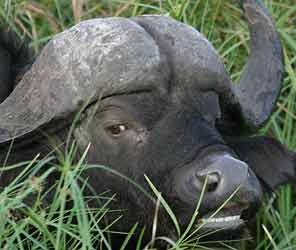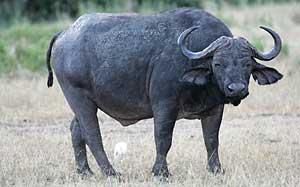Contact Details: Scotch Macaskill, Dirt Road Traders, Currys Post Road, Howick, KwaZulu-Natal, South Africa. Tel: +27 (0)82 578 2329. Privacy: Your privacy is guaranteed. See our Privacy Policy for more. This site accepts advertising and other forms of compensation - see Disclosure and Advertising for details. Site updated: 2022. Copyright © 2002 - 2022 Scotch Macaskill

| ||||||||||
|
||||||||||
|
See also info about: |
African Buffalo Information

Buffalo bull, showing the thick, heavy "boss" where the horns meet on top of the head
Appearance:
Both sexes have large grey horns of around 100 cm long stretching across the forehead and curving upward to form the shape of a "W". The broad base where the horns meet is called the "boss" and is thicker and more prominent in males. The buffalo's ears are large and hang down just below the horns. The tail is cow-like with a tip of long brown or black hair. Behavior:
Bachelor groups may, however, break away from the main herd, and solitary bulls are often encountered. Adult bulls, within the mixed herd, form a dominance hierarchy. Buffalo are often seen drinking in the early mornings or late afternoons, and they spend the heat of the day seeking out shade. Feeding mostly takes place at night. The buffalo can reach speeds of around 56 km per hour and can therefore outrun a lion, however they are slow starters and this is why they are often easy prey for lions. They are nevertheless quick tempered and dangerous, deserving of their status as one of Africa's "Big Five" in the wildlife kingdom.
Reproduction:
Diet:
Sounds:
While grazing, a series of sounds like short lowing, growling and rumbling can be heard, to keep the herd moving in the right direction. For additional information on African buffalo, see our gallery of Buffalo Pictures. Return to Wildlife Info . |
|||||||||
|
|
||||||||||

